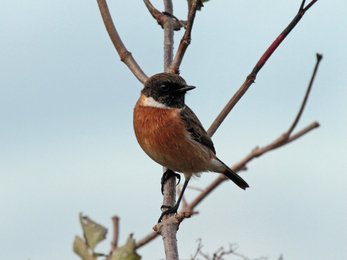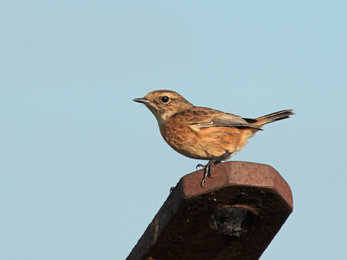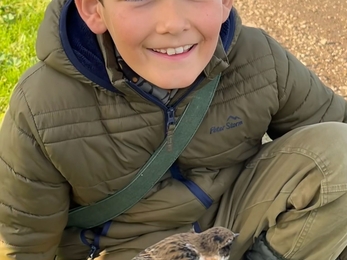Certain bird species are suitable for monitoring and research in the Great Fen, especially those that perch in prominent positions, making it easier to identify them. Due to their presence throughout the winter, coupled with the possibility of regular breeding in the future, stonechat have been selected as one such species.
Stonechats are slightly smaller and more slender looking than robins. Males have black heads and a white collar around the neck, with a bright orange breast and a mottled brown back. Females have a brown head and back, with an orange tinge on the chest. They have a call that sound like two stones being tapped together, hence the name 'stonechat'.
Records of these birds, in winter, are widespread in the Great Fen restoration land. Birds are often seen from trails, such as the Dragonfly Trail at New Decoy, and the Last of the Meres Trail (including the Northern Loop). Birds can been seen hovering, hummingbird-like over reeds and small shrubs in the ditches in the Fen.
As these birds will be moving around within the Fen, and then migrating back out, studying them could add greatly to the information we have on how wildlife is using the Great Fen and its variety of different habitats.
Bird ringing is a tried and tested method of gathering important data about our bird populations. At the Great Fen we work to see how we can generate as well as use scientific knowledge, about wildlife, and apply it to our habitat management, and so enhance the conservation work we are doing. This will also help us to demonstrate how we are benefitting wildlife, through our progress with building a Nature Recovery Network with the Living Landscape approach.
In 2020 we started colour-ringing the stonechats in and around the boundary of the Great Fen. This involves adding light-weight colour rings to the legs of the birds; one on the right leg of the bird, and one above a metal numbered ring on the left leg.
Due to the perching nature of these birds, and the high level of bird monitoring and birdwatching in the Great Fen, re-sighting (subsequent sighting and reporting of the colour-ring birds and their ring combination), should provide regular data on these birds, within and beyond the Great Fen. Wildlife Trust staff, and voluntary monitors (the ‘Great Fen Monitors’), will be involved in re-sighting, as well as other partnership staff and local bird-watchers.
Through collaboration with similar projects, such as that at Dersingham Bog, it will be fascinating to see where such birds are moving in this part of the country. Liaising with Natural England at Dersingham has been very interesting, as they and the volunteers progress their study into the stonechat, which started breeding there in 2005.
In terms of the Great Fen stonechats, we have a ring combination of a colour ring above a metal ring on the left leg, and a colour ring on the bird's right leg. Colours include solid and multi-coloured rings, such as those seen below.
Check out the sightings and blogs page for updates on our progress, and if you have any sightings or photographs, historical or recent, of stonechat or other birds, with or without rings, contact Henry Stanier. For further information, you can request a talk on this topic, for your local wildlife group.



